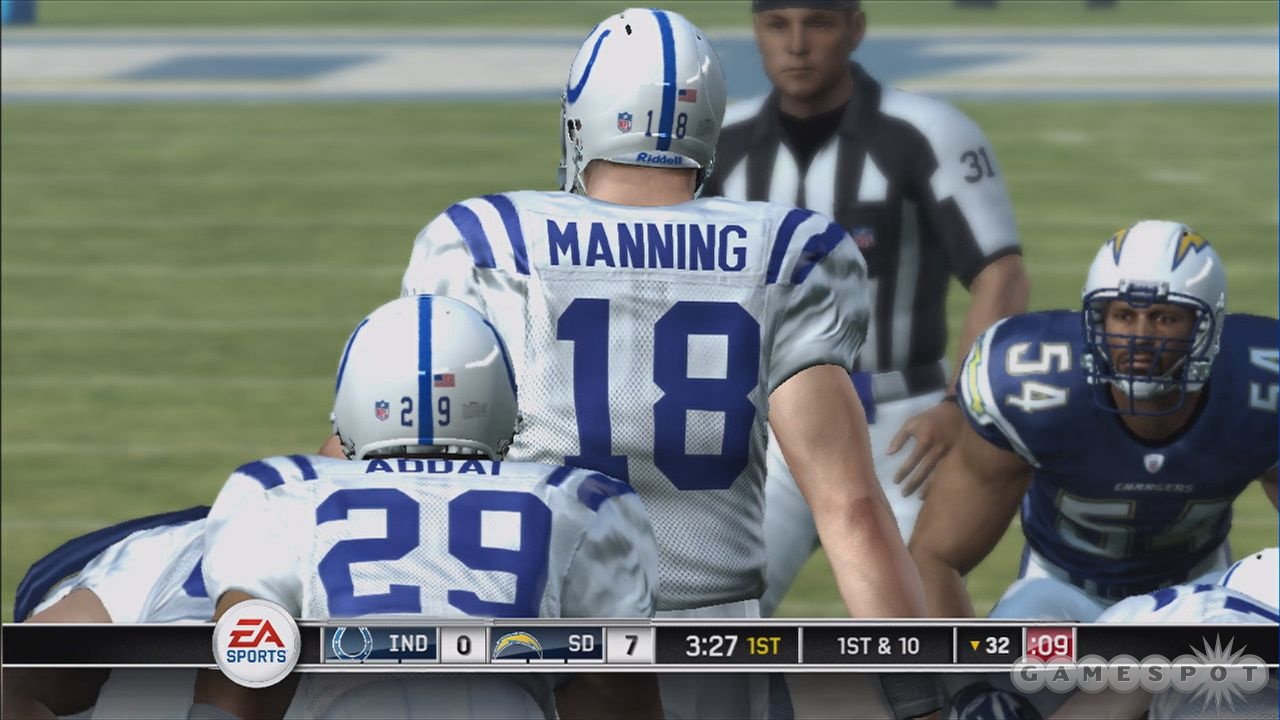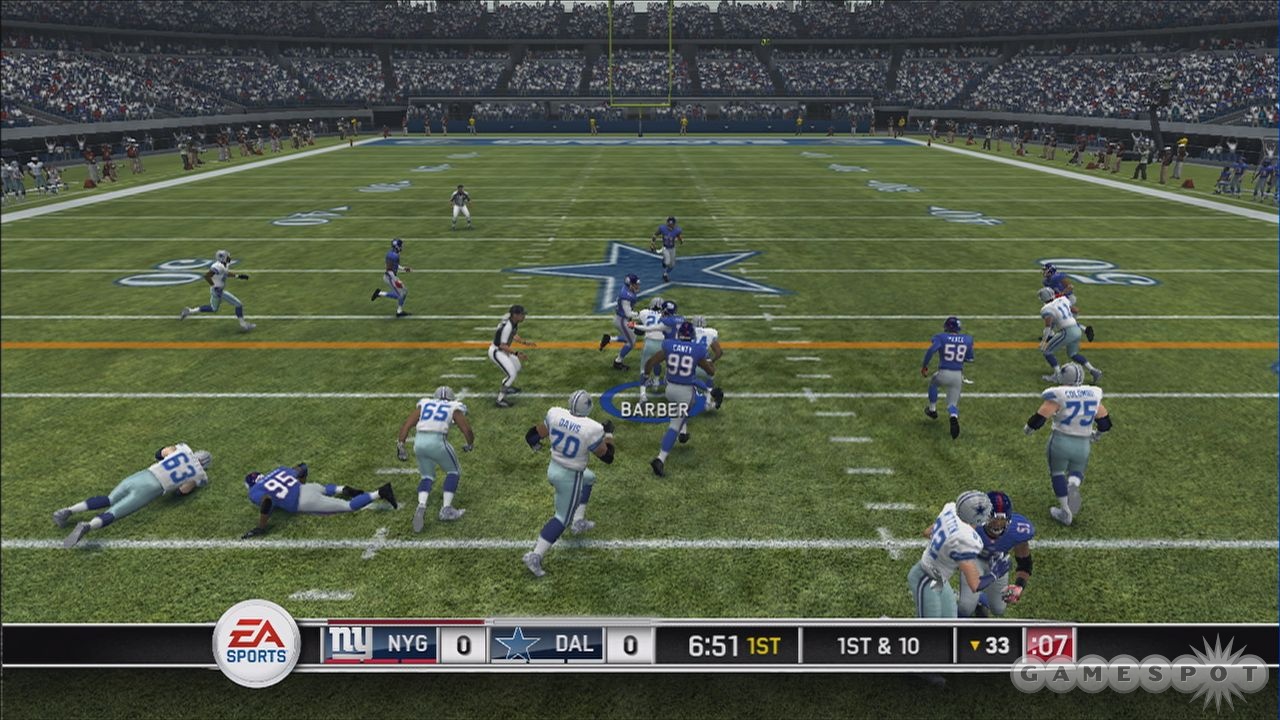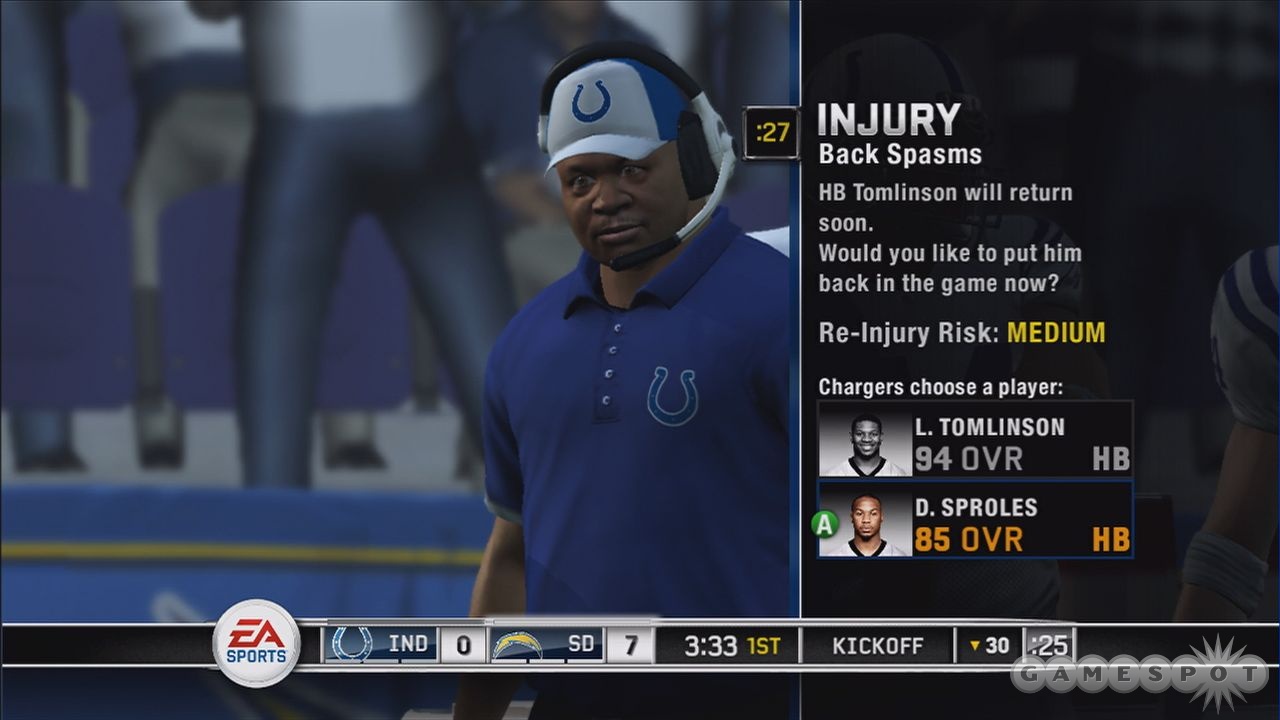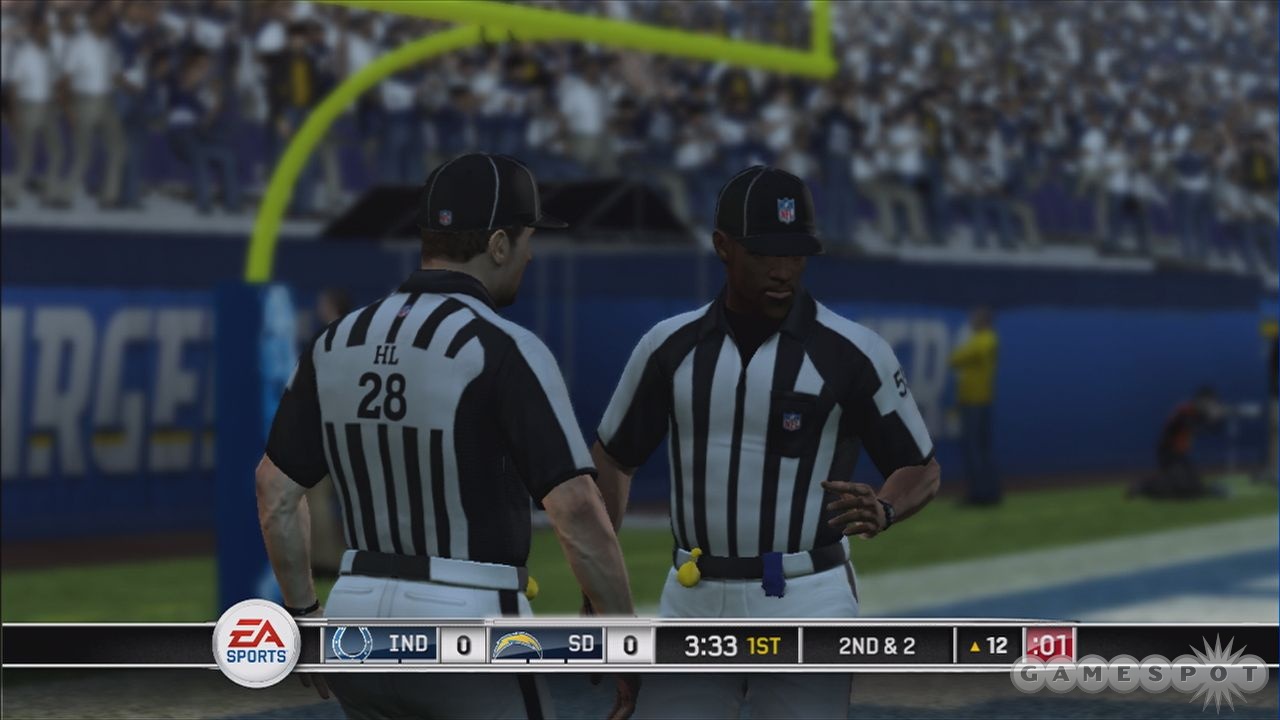With every new Madden release, there are almost always one or two features that get the bulk of the attention--features that not only make the current Madden different from its predecessors, but also seemingly make the upgrade from one year to the next worthwhile. Madden NFL 10 is no different in this respect. Some of its new features are substantial, like the long-awaited Online Franchise mode or the new types of tackles generated by the Pro-Tak system, but it feels like most of what's new in Madden 10 is less glossy and far more granular, affecting only the mechanical aspects of the football experience. It's almost as if Madden 10 represents a back-to-basics philosophy for the franchise, taking the focus away from fancy modes and even fancier presentation elements for the purpose of making the sport itself the main draw, but there are still many lingering problems.
There's evidence of this philosophy in the way prominent features from last year's game take a backseat. For example, last year's Madden Test--which assesses your ability based on a series of cool-looking hologram drills--is back, largely unchanged, but it's buried under the quick-modes option. Even the stylized menus from Madden 09 are gone and have been replaced with a more streamlined interface that lets you get to where you need to go quickly, whether you're signing a free agent or trying to look at some key stats.
Obviously, this is of great benefit to the Franchise mode (both online and off) since the most fervent Madden players spend a good portion of time navigating in and out of menus to build the best team possible. But aside from that, the Franchise mode remains unchanged on a superficial level. It does include a new presentation element in the form of a show called The Extra Point, hosted by the NFL Network's Fran Charles and Alex Flanagan. This functions as a recap and halftime show that goes over the basic stats of a specific game or the results of the previous week with some very light commentary that doesn't offer all that much insight. However, one aspect of this show reveals one of the Franchise mode's biggest potential shortcomings.
At the end of any week, The Extra Point gives a player the Offensive Player of the Week or Defensive Player of the Week award, depending on his position. Despite numerous occasions when players had an almost supernatural performance for five-minute quarters, not once did any of them receive the recognition. They were always awarded to individual players on AI teams. After looking at stats of these players from other teams in the Franchise mode, it becomes apparent that there are two parts to this problem. The first is that some players, like Tom Brady, are just that good and should probably win such awards, but the second is far more devious: stats don't seem to scale properly for five-minute quarters. In other words, when the computer plays its games, those stats are designed to reflect full quarters, or at the very least, they reflect a simulation of a "full" game. They aren't representative of truncated quarters where there simply isn't as much time to wrack up as many yards, completions, sacks, or touchdowns as the stats suggest.
It's hard to gauge how much this affects other aspects of the Franchise mode, such as player progression--if it does at all. At the end of every season, a player's overall rating changes based on a number of factors, including overall performance, potential, and age. But even this process seems a little inconsistent. One player, who was also injured for most of the season, received the biggest hike in the overall rating, while another player in the same position, who was far older and had an OK season, dropped only a single point. There is just no way to tell how the categories are weighted and if playing truncated quarters means that your players won't progress the same way that players on computer-controlled teams do.

Fortunately, playing an online franchise mitigates a lot of these problems provided you fill most of the spots with other people and not just computer-controlled teams. But it also has its own share of issues--the biggest being that there aren't any salary restrictions for free agents. If you happen to see a top-tier player out there and want him on your team, all you need to do is clear a spot for him on your roster and it's done. Granted, players participating in a franchise can determine whether or not to let things like that happen, depending on how dedicated they are, but it seems silly to not have some restrictions in place by default. Likewise, CPU trades can happen unchecked--you can dump the worst player on your team for the best on another if that team happens to be controlled by the computer. Thankfully, the commissioner can turn this off completely, but it would have been nice to see some additional parity between the offline and online Franchise modes when it comes to some of these front-office features.
Still, the online Franchise mode does a lot of things really well. Those who have played NCAA's Online Dynasty will instantly recognize the basic setup where all participants flag whether or not they're ready to play the week. If some players lag behind, the commissioner can force the franchise to move forward, and if the commissioner cannot fulfill his duties for any given week, he can promote another player and have him take on the role. Additionally, the commissioner can set the amount of time players have to make their decisions in the draft--a useful tool for making the 54-players per roster fantasy draft run a little smoother.
Whether you're playing offline or online, Madden NFL 10's gameplay tweaks are equally evident in either situation. The much ballyhooed Pro-Tak system (a fancy term for better gang tackles) works as advertised, with numerous players clinging to the ball carrier before dragging him down in some situations. This feature also adds some much-needed muscle to the running game, making it feel as though you're really fighting and scraping to get those few extra yards out of a run on offense and stuffing a running back with five or so players on defense. At the same time, however, it seems easier to evade solo tackles in Madden NFL 10 than it did in previous Madden games, allowing you to execute some spectacular breakaway plays if you're on offense. This generally happens when you have a one-on-one situation--something like a running back against a cornerback. If he performs a single spin move on that corner, there's a pretty good chance that running back is going to break for at least a 20-yard run, if not a touchdown. That might not seem completely unrealistic until you see it happen over and over again, or when you see a normally less-than-agile tight end perform the same feat.

Madden 10 does have an inadvertent method for preventing too many breakaway plays, which takes the form of poor downfield blocking. Imagine running the ball up the field. You've blown by the linebackers and the corners, and there's only your back holding the ball, a teammate, and a safety. Too often, your teammate will run in the opposite direction (back toward the linebackers) instead of running forward and taking out the safety to clear your way to the end zone. This also happens near the line of scrimmage where the fullback will occasionally run forward and then suddenly dart to the side and completely miss the linebacker who's bearing down on the halfback. Of course, these things happen in the real NFL, so it's not unreasonable to expect them here, but they happen too often.
There are similar gaffes in the overall defensive schemes of AI opponents. In most games, it genuinely feels like the AI sees the plays you're running, analyzes what's working and what's not, and then adapts accordingly to shut you down. There are also times when you have to work the run before you can get any sort of passing game going. Then there are the stretches in a drive of a different game where you can run the same play repeatedly, and no matter what the AI does, it can't seem to stop you--and this is with the AI using some of the best defensive teams in the league, no less. Still, it's worth noting that pass defense is generally better and more realistic, and it's far more difficult to abuse the same pass play made to the same player on back-to-back downs, even on slant routes. The AI also seems to be particularly adept at making it difficult to throw the ball more than 15 yards down the field in a consistent manner, but this better pass defense also means that the frequency of interceptions is still relatively high.
Part of the reason the pass defense is better is that quarterback behavior falls more in line with real-world boundaries. If a quarterback who has no scrambling ability at all tries to throw a ball on the run, there's a good chance he's going to fling the ball up in the air with little accuracy. Likewise, if your quarterback doesn't have the best arm strength in the world, then you simply shouldn't try to launch the ball down the field. It's important to find a rhythm and to pinpoint the things your quarterback is good at doing as opposed to trying to abuse the same routes and force the ball down the field. And if you get to the point where you can combine that skill with the ability to identify a blitz, you can kill the defense with a huge gain almost every time. But one major complaint with the position is still this: Quarterback sneaks are still way too easy to abuse. Forgoing a punt and running a QB sneak on fourth and two should be a much greater risk than it currently is.

It's worth mentioning that fatigue on the default setting plays a much greater role than it did in previous games, which makes it harder to abuse other types of plays. If you keep passing to your star receiver, that receiver's stamina will drop to the point that he automatically gets pulled for a play or two before being sent back into the game. The same applies to your running backs. Unfortunately, the game also seems to punish repetitive play-calling with injuries. Your teammates go down way too often in Madden 10. Most of the time it's a small injury that takes a player out of the game for a few plays, but the bigger injuries (ones that take him out for the rest of the game) occur more than you'd suspect or want. There are some occasions when you have the option to bench a player after his injury has been assessed. Oftentimes, however, he'll automatically return to the game even if the injury has been deemed as "medium," which means there's a high risk for an even more severe injury.
Madden 10's look is an improvement over last year's game, but most of it comes in the form of finer details on the player models, such as patches, and presentation elements that help give the game a more broadcast-TV feel. Cutting back on the number of referee deliberation cutscenes would have been nice. As it stands now, they run far too often. In addition, the stadiums look fantastic, but there are some nitpicky issues here and there. At various times, and for no discernable reason, the fans in the stands will face the wrong way with their backs turned to the field. Also, the depth-of-field effect (where objects in the foreground are blurred) looks way overdone in some of the cinematics and tends to cause a slight visual distortion on the field before a play, albeit for just a second or two.
The commentary is by far the weakest aspect of Madden NFL 10's presentation. As always, Chris Collinsworth tries his best to make some interesting comments in certain situations, particularly on the special Backtrack replay segments where he breaks down the play and shows you what went wrong. He's not really the problem, but his play-by-play man, Tom Hammond, is absolutely terrible. His commentary is completely bland and lacks any sort of dynamic that gives context to on-field action aside from the most basic observations. And because he's terrible, there's rarely interesting second-to-second commentary or back-and-forth chatter between the two. There are also moments when it seems like there should be commentary from Hammond (or Collinsworth, for that matter), and there's just none at all. This is especially noticeable in the pregame segments and at the end of a game.

There's a real sense that EA wants to get back to the fundamentals of football with Madden NFL 10, and many of the changes it has made in that respect are good ones. The running game feels great, and the passing game is much improved over previous iterations. The Pro-Tak system works just about as well as you'd want it to, and the inclusion of online franchises (while featuring some dubious options) is a pretty good reason to dive into this year's game. Even the new online co-op option, which lets you and another player take on the computer, is a nice addition. There's just something satisfying about completing a bomb to a receiver controlled by a friend and not the AI, but this mode still needs some attention when it comes to camera work and positioning--it's a little too disorienting and a little too close to the action. But for all of these improvements, there are seemingly an equal number of nagging setbacks, ranging from the frequency of turnovers to inconsistencies in AI-controlled defenses. Of course, these don't sink the entire Madden 10 experience, since it's still a fun game to play, but a little more tweaking in these areas could have gone a long way in making this the best Madden to date.